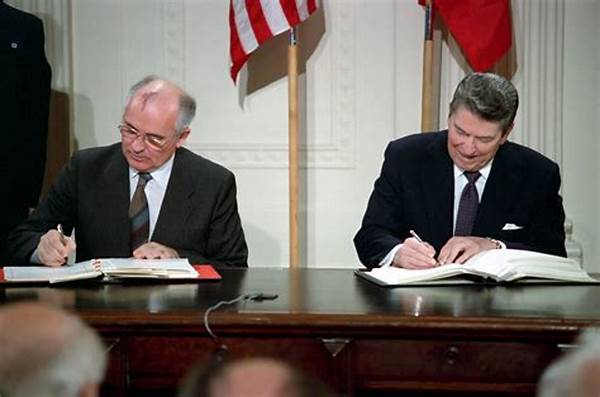Historical Context and Importance
The Intermediate-Range Nuclear Forces Treaty (INF Treaty), signed in 1987 by the United States and the Soviet Union, marked a pivotal moment in Cold War diplomacy and arms control efforts. This agreement sought to eliminate an entire category of nuclear and conventional ground-launched ballistic and cruise missiles with ranges of 500 to 5,500 kilometers. Born from years of intense negotiations and political strain, the treaty reflected mutual understanding between two superpowers acknowledging the imminent threat posed by the proliferation of intermediate-range missiles in Europe and beyond. It underscored a significant step forward in cementing strategic stability, reducing nuclear arsenals, and building trust among nations. The INF Treaty not only facilitated a substantial reduction in nuclear stockpiles but also paved the way for subsequent treaties aimed at furthering global non-proliferation and promoting peace.
Provisions and Verification Mechanisms
The Intermediate-Range Nuclear Forces Treaty included detailed verification mechanisms, which were unprecedented at the time. This rigorous framework encompassed on-site inspections, data exchanges, and continuous monitoring, assuring compliance by both parties. Furthermore, it inspired confidence and paved the way for future arms control agreements.
1. Mutual Compliance: The Intermediate-Range Nuclear Forces Treaty mandated both countries to eliminate nuclear and conventional ground-launched ballistic and cruise missiles with ranges between 500 and 5,500 kilometers, ensuring sustained compliance through stringent verification protocols.
2. International Security Enhancement: By eradicating an entire class of missiles, the Intermediate-Range Nuclear Forces Treaty considerably enhanced global security and stability, lowering the risks associated with nuclear escalation between the United States and the Soviet Union, and reassuring European allies of reduced threats.
3. Role of Verification: As a hallmark of the Intermediate-Range Nuclear Forces Treaty, verification mechanisms, including on-site inspections, played a crucial role in fostering trust and cooperation. This breakthrough approach set a benchmark for future arms control accords, exemplifying transparency and accountability in treaty implementation.
4. Influence on Future Treaties: The success of the Intermediate-Range Nuclear Forces Treaty influenced subsequent arms reduction agreements, such as the Strategic Arms Reduction Treaty (START), reinforcing the significance of negotiation as a tool for conflict resolution and fostering international peace.
5. End of an Era: The termination of the Intermediate-Range Nuclear Forces Treaty in 2019 marked the end of a vital chapter in arms control, sparking renewed concerns over nuclear proliferation and the need for a renewed commitment to global disarmament efforts to maintain international security and stability.
Challenges and Criticisms
Despite its successes, the Intermediate-Range Nuclear Forces Treaty faced numerous challenges and criticisms over the years. One fundamental issue was the evolving geopolitical landscape, which saw new actors and technologies emerge, thereby complicating the treaty’s applicability and relevance. Allegations of non-compliance by both the United States and Russia arose, straining diplomatic relations and eroding trust that had been painstakingly built over decades. Critics argued that the treaty failed to account for other countries developing similar missiles, notably China, which was not a signatory and thus not bound by the treaty’s restrictions.
The eventual collapse of the Intermediate-Range Nuclear Forces Treaty in 2019 raised apprehensions about the future of arms control, with voices from both parties citing persistent violations as a rationale for withdrawal. This termination not only underscored the fragility of international agreements but also highlighted the pressing need for comprehensive frameworks encompassing a broader range of nations. The unraveling of the treaty served as a poignant reminder of the inherent challenges in maintaining and enforcing such pivotal accords in an ever-evolving global landscape.
Lessons and Future Implications
The history of the Intermediate-Range Nuclear Forces Treaty offers insightful lessons and implications for future arms control endeavors. Critical among these lessons is the necessity of adapting agreements to keep pace with technological advancements and shifting geopolitical dynamics. The treaty’s initial success demonstrated the effectiveness of robust verification mechanisms, transparency, and mutual trust as foundational pillars of any sustainable arms control agreement.
Moving forward, it is imperative for the international community to engage in dialogue and diplomacy, fostering new accords that account for the diverse array of contemporary security challenges. The legacy of the Intermediate-Range Nuclear Forces Treaty underscores the importance of comprehensive, inclusive negotiations that incorporate a broader spectrum of stakeholders. By doing so, future agreements can mitigate the risks of nuclear proliferation and foster enduring global peace and security.
Impact Assessment and Long-term Significance
Assessing the impact of the Intermediate-Range Nuclear Forces Treaty requires an acknowledgment of its profound influence on Cold War diplomacy and subsequent arms reduction efforts. The treaty initiated a significant reduction in nuclear arsenals at a time when the threat of nuclear conflict was palpable. This momentum, however, must be diligently sustained through continuous engagement and adaptations responsive to emerging threats.
Long-term, the lessons from the Intermediate-Range Nuclear Forces Treaty must inform the creation of flexible, inclusive frameworks that address the complexities of today’s international security environment. Securing global peace necessitates a coalition of nations committed to transparent, verifiable disarmament measures that preclude the escalation of nuclear threats. By reinforcing these principles, the spirit of the Intermediate-Range Nuclear Forces Treaty can guide future endeavors to establish a stable and secure world order.
Conclusion
In summation, the Intermediate-Range Nuclear Forces Treaty stands as a landmark achievement in the domain of arms control, symbolizing the potential of diplomacy and negotiation to substantially alleviate the fog of nuclear threat that once loomed large over the world. While the treaty’s dissolution in 2019 marked a somber juncture, it accentuated the urgent need for renewed efforts in the realm of disarmament and international cooperation.
Despite its cessation, the Intermediate-Range Nuclear Forces Treaty remains a beacon of what is achievable through sustained diplomatic engagement, robust verification measures, and trust-building. As the international community navigates the complexities of contemporary security challenges, the treaty’s legacy offers invaluable insights and serves as a blueprint for crafting resilient frameworks aimed at promoting enduring global peace and security.





